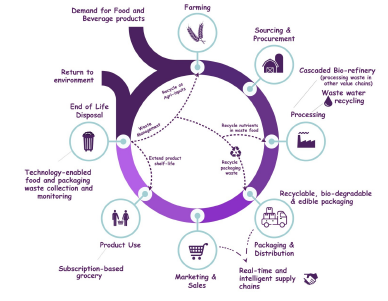

Lalith Kumar Vemali & Rakesh Gandla
C0003
March 2023
Circular economy is an emerging approach to economic growth that aims to keep resources in use for as long as possible, by designing out waste and pollution, and regenerating natural systems. Fast Moving Consumer Goods (FMCG) industry that produces and sells consumer goods that are frequently purchased and consumed, known for its high volume of production and consumption, leading to significant environmental impacts. In this case study, we will examine the circular economy initiatives taken by a leading FMCG player Unilever and explore opportunities, success factors and enablers for adoption of circular economy in Indian FMCG sector.
Unilever is a British-Dutch multinational consumer goods company that produces and sells a wide range of products, including food, beverages, cleaning agents, and personal care products. The company has set ambitious goals to reduce its environmental impact and increase its positive social impact. Unilever's circular economy strategy is centered around three main pillars: designing for circularity, reducing waste, and increasing reuse and recycling.
Designing for circularity: Unilever is committed to designing products that are more sustainable and can be recycled or reused at the end of their life. The company has set a goal to make all its plastic packaging reusable, recyclable, or compostable by 2025. Unilever is also exploring new business models, such as refillable and reusable packaging, which allows customers to use the same container repeatedly.
Reducing waste: Unilever is working to reduce waste in its operations by implementing efficient manufacturing processes and reducing the amount of packaging used. The company has set a target to achieve zero waste to landfill by 2025. It is also investing in new technologies, such as biodegradable materials and compostable packaging, to reduce its environmental impact.
Increasing reuse and recycling: Unilever is working to increase the amount of materials that can be reused & recycled. The company has set a target to use at least 25% recycled plastic in its packaging by 2025. It is also working with governments & NGOs to improve waste management infrastructure in countries where it operates. It has launched initiatives to encourage consumers to recycle, such as providing recycling bins in public spaces.
Unilever's circular economy initiatives have had a positive impact on the environment and the company's bottom line. By designing products for circularity and reducing waste, Unilever has reduced its carbon footprint and waste sent to landfill. The company's refillable and reusable packaging business models have also been successful, with increased customer engagement and loyalty. Unilever's initiatives to increase the use of recycled materials and improve waste management infrastructure have also helped to increase recycling rates.
Unilever's circular economy initiatives demonstrate that the FMCG industry can be a powerful force for sustainable development. By designing products for circularity, reducing waste, and increasing reuse and recycling, Unilever is setting an example for other companies to follow. As consumers become more aware of the environmental impact of their purchases, companies that embrace circular economy principles will be better positioned to meet their customers' demands and succeed in the marketplace.
According to research, the value of India's GDP may be preserved through the use of circular economy business models by 2030 in India and $4.5 trillion globally. This would include eliminating waste, but not waste in the sense of trash, but rather any underutilization of assets, products, and natural resources.
| Resource criticality | Ongoing initiatives | Evolving trends / Outlook |
|---|---|---|
| Indian major agricultural commodity harvest and postharvest losses are estimated to be about $143 million annually. | The government is actively promoting the food processing industry as a strategy to solve supply chain losses (today, only 10% of product is processed). | Precision agriculture use is growing quickly at the farm level to enable efficient resource use. |
| 90% of food loss in India occurs between the stages of manufacturing and sales, while just 10% occurred during the eating / consumption stage. | A bill called Marriages (Compulsory Registration and Prevention of Wasteful Expenditure) The 2016 wedding food waste control bill was introduced. | Digital technologies are enabling the rapid development of integrated agricultural supply chains. For instance, AgriDigital is a start-up developing an integrated platform that will digitise the supply chain and build a postgate farm system that will bring traceability. |
| The wasted food wastes 19.7 million hectares of land and produces a 46.5 megaton carbon footprint. | Food surplus and the impoverished are being connected by startups like Feeding India, although the scale is still rather limited. | Pay-per-use grocery services like Cirkle, Tesco's creative packaging, and food sharing platforms like Olio all contribute to extending product life and decreasing waste. |
On the World Hunger Index 2022, India is now ranked 107th out of 121 nations, with almost 25% of the worlds undernourished people residing there. High food waste further exacerbates the problem of hunger; in India, about 40% of agriculture product is thrown away each year. Unlike to affluent nations, where food wastage predominantly affects the consumer and post-consumer stages, food wastage in India occurs throughout the whole value-chain. In actuality, the phases of consumption only account for 10% of food waste in India.
In terms of resource efficiency, the agriculture sector in India confronts difficulties in the early stages of the value chain. For instance, India has a significantly higher fertiliser intensity (measured in kg/hectare of arable land) of 165 than the average level for the world, which is 138. This causes nutrient cycle leaks and soil deterioration. This problem is made worse by the practise of burning crop waste, which removes 1.4 million tonnes of nutrients from the topsoil.
The value chain's midstream stages have difficulties with regard to supplier security. The pricing of raw materials essential to the FMCG business have fluctuated significantly during the past few years. For instance, the cost of crude palm oil climbed by 90% in 2022, compared to a 20% increase in the cost of commodities like wheat, coffee, and tea. The industry faces a serious supply risk as a result of rising pricing. The leakage of micronutrients at this step of the value chain presents additional difficulties. For instance, during processing, 58% of the iron in wheat is lost.
Plastic waste is a significant resource challenge that is encountered at the downstream stages of the value chain. India presently consumes less plastic per person than the average country worldwide. Nonetheless, India's demand for plastic is anticipated to increase, particularly due to increased demand for packaging. The scale of food and plastic waste along with the difficulties in maximising resource efficiency throughout the value chain underscore the necessity of adopting circular business models.

Adopting new business models that have the potential to alter an industry is necessary for circular models. Over $500 billion of India's GDP is at danger (by 2030), therefore the stakes are very high. To take advantage of this immense opportunity, an enabling environment that promotes the discovery and acceptance of innovative business models is necessary. According to research, India would need to have these five things in order to fully utilise the potential of circular business models: Increased awareness, innovative funding structures, enabling policy environment, disruptive technology, collaboration and partnerships
The transition to a circular economy demands a methodical and well-considered implementation roadmap, which can only be created and carried out through cooperation among many stakeholders. Government and the commercial sector are in a unique position to affect this journey given the scope and influence. It is crucial to approach this change as a national undertaking with definite goals and timetables. A systematic shift to a circular economy could be shaped by a number of efforts.
| National programmes to create a favourable ecosystem | Action plan at the sector and material levels | Pilot projects, proof-ofconcepts, and scale-up |
|---|---|---|
| A national strategy with guiding rules and a legal foundation | Adoption of Circular Economy as a CEO agenda | Dedicated capacity building programs (ex. trainings for skill development) |
| Creation of a comprehensive national circular economy policy framework that incorporates current laws and regulations | Baseline evaluations of the materials, sectors, and risks & opportunities | Platforms for dissemination of best practices |
| Fiscal measures like levies on nonoptimal resource utilisation and incentives for the private sector | Sector and material prioritisation for the short-, medium-, and long-term action plans | Cross-sector idea generation workshops / R&D investments |
| Monitoring and evaluation framework | Partnerships with technology providers, start-ups and other players | |
| Educational curriculum-level intervention | Innovation showcase platforms |